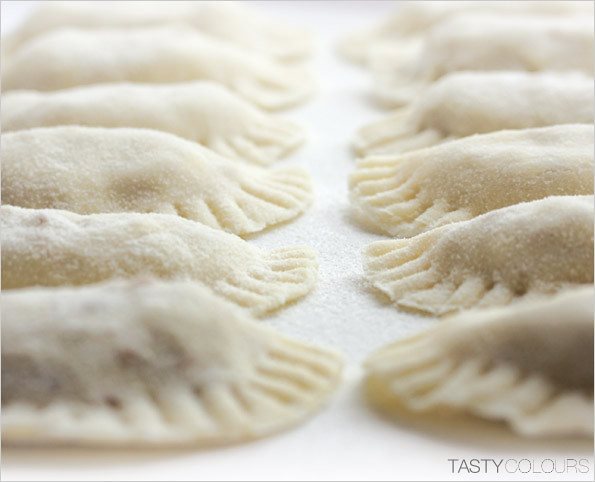Serves 4
The following quantities will make about 440 g of dough.
If properly rolled out, it will make about 40 to 50 pierogi.
Dough
Ingredients
280 g flour (have some extra flour handy to adjust the recipe and to work the dough and roll it out)
½ teaspoon salt
1 egg
1 teaspoon butter
100 ml mineral sparkling water, at room temperature (have some extra water to adjust the recipe)
Preparation
Sift flour on your working table.
Form a well in the centre of the flour.
Place the egg, salt, butter in the well and mix all the ingredients with as much flour as possible.
Then start adding water, 2 tablespoons at a time. Knead the dough so the water is completely absorbed before adding the 2 following tablespoons of water. Should you add too much water, the dough will become sticky; in that case, add little by little the extra flour until the dough is no longer sticky.
Knead the dough for about 15 minutes; it should become smooth, shiny and elastic.
Divide the dough into 2 equal parts.
Place the first part on your working table.
Wrap the second part in a plastic film and put aside.
Sprinkle some flour on your station and start rolling out the dough until it is between 1 and 2 millimeters thick.
Occasionally, flip the dough and sprinkle some flour over it so it does not stick to the table.
Preparation of pierogi – instructions applicable to all types of pierogi presented in my blog
When dough is rolled out, cut disks of between 4 to 6 centimeters using a cookie cutter or, if not available, a kitchen glass.
Put the scraps of leftover dough together and gently knead to form a small ball. Wrap in plastic film and put aside to roll out later.
Place about 1 teaspoon of stuffing in the middle of each disk.
The stuffing must not reach the edge of the disk or it will prevent the proper sealing of the pierogi.
Fold disk in half and pinch edges together.
Should the dough be too dry, it will not seal properly. In that situation, use a brush to moist the edges of the disk, and pinch them together.
Place pierogi on a flat dish sprinkled with flour, and cover with a light cotton towel.
Repeat to prepare pierogi from the second part of dough and scraps.
Cooking of pierogi – instructions applicable to all types of pierogi presented in my blog
In a large saucepan (about 5 liter capacity), bring to a boil 3 liters of water; add some oil and a flat teaspoon of salt.
Drop a few pierogi at a time, bring again to a boil and reduce flame.
When pierogi rise to the surface, let simmer another 3 to 4 minutes.
Taste one of the pierogi to check that the dough is well cooked.
Do not strain them; use a slotted spoon to remove them from water and place over a paper towel to remove the excess of water.
Serve immediately according to your particular pierogi recipe.
Pierogi is the name of famous Polish half-circular dumplings made from noodle flour dough, finely rolled, cooked and stuffed with various fillings.
Despite the cultural and culinary changes in last twenty years, they remain one of the most popular Polish daily dishes, usually served in fast restaurants, school cantinas and at home. You can buy them as well in every food shop in Poland, usually frozen.
Pierogi are known in Poland probably since the middle ages and had been incorporated into Polish culinary tradition from the Far East through the Kievian Rus. The word “pierogi” appeared in Polish language in the XVIIth century.
The most traditional fillings of the pierogi are: cooked, mashed potatoes with curd cheese and onions, ground meat, cooked or pickled cabbage with mushrooms, buckwheat kasha, curd cheese with sweet or spicy additions, spinach, bryndza cheese, seasonal fruits such as strawberries, bilberries, cherries, wild cherries and, in some regions of Poland - lentils.
On the other hand, the imagination of my compatriots in pierogi field developed over the last years and does not know any limits. In many Polish cities you can find fancy pierogi houses – called “pierogarnia”, small restaurants exclusively serving pierogi. There, you can eat pierogi with more sophisticated fillings, expensive and unusual stuffing.
Today rich pierogi reality reminds me of the times when I was a school girl eating her obiad in a school cantina every day for 12 years. During my school times I became an enemy of all Polish traditional flour dishes. The school reality in the eighties was very often not tasty. School pierogi dough was thick, tough, not tasty, gluey with a little bit of the stuffing, so little, that you nearly could not feel it when eating.
After I left for France and despite my further fascination with cooking from foreign countries, I started to discover again Polish food. I had been investigating older members of my family about traditional recipes for classical Polish dishes, including the good recipe for the pierogi dough.
In Poland, there are tens (or maybe even hundreds) recipes for the pierogi dough. I can say that there are as many recipes as households preparing pierogi. However, the best pierogi are those which have a very fine, elastic dough and a lot of tasty stuffing inside. My family classical pierogi recipe consists in flour, sparkling mineral water and salt. It is easy to roll it very finely.
Pierogi need small accompaniments. Salty pierogi go ideally with clarified butter, caramelized onions, fried bacon, lard or crème fraiche. I like to add fresh parmiggiano or oscypek and to sprinkle them with fresh greens: chopped chives, parsley, green onions, fresh mint, thyme or other favorite herb. Sweet pierogi taste best with cream or thick yogurt mixed with some vanilla and sugar.
Pierogi taste delicious the day after, especially if you will grill them in a frying pan with a bit of butter. They also freeze very well, so you do not have to eat everything at once.









3 comments:
I've only had savory pierogies, but reading your description of cream, vanilla, and sugar makes me crave a sweeter pierogi.
I'm going to have to give your recipe a whirl!
Sweater pierogi may be served for dessert, although in Poland quite often they are served as a main course (especially, in summer time). Take care!
I always try to make perfect pierogi but my dough never works well. it always becomes real hard instead of soft. Help me with this problem, please.
Post a Comment